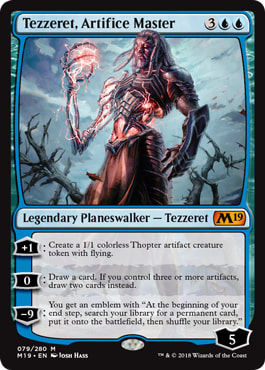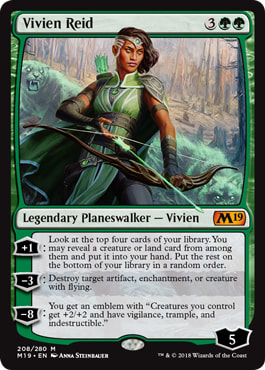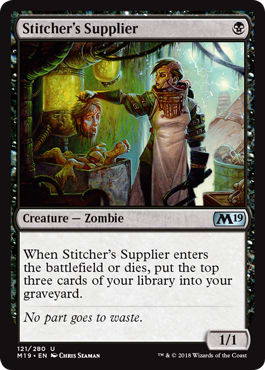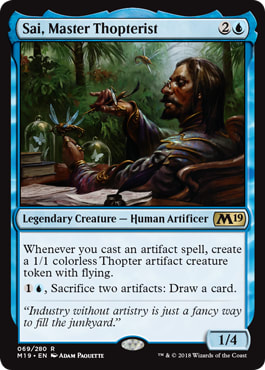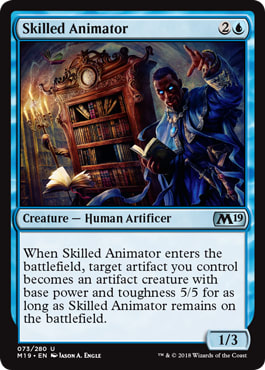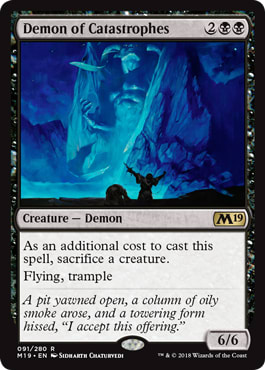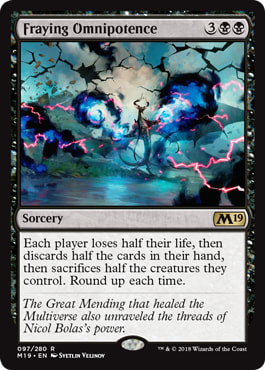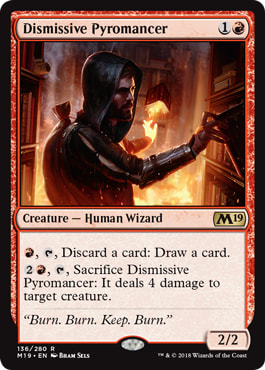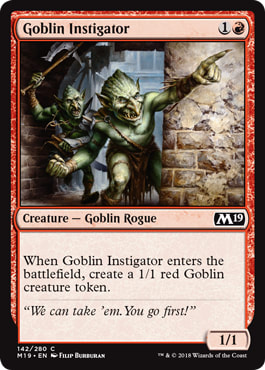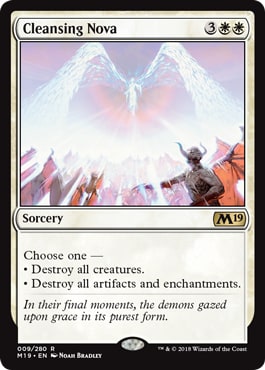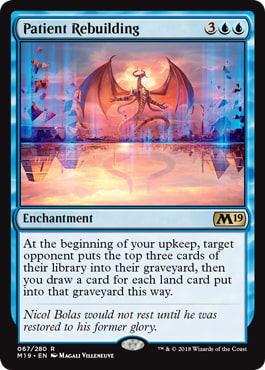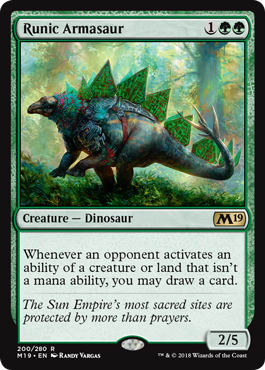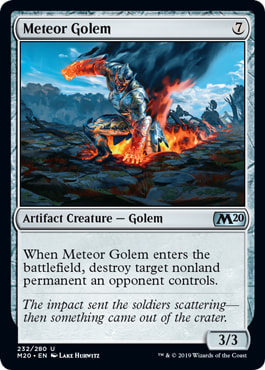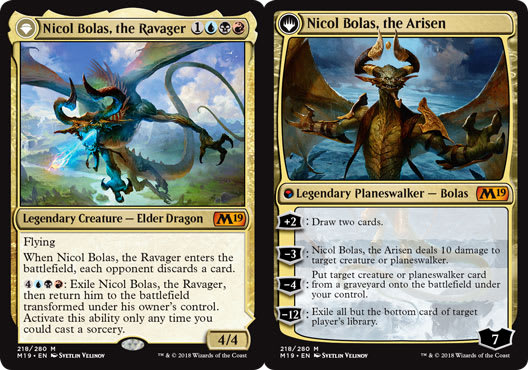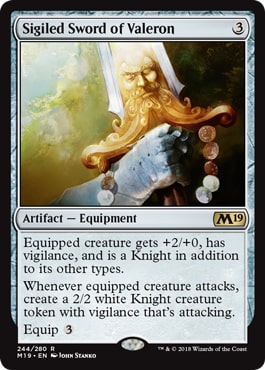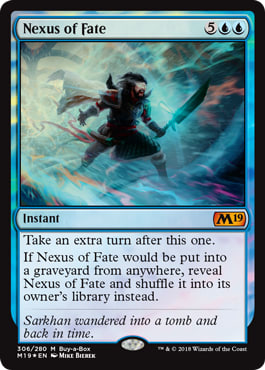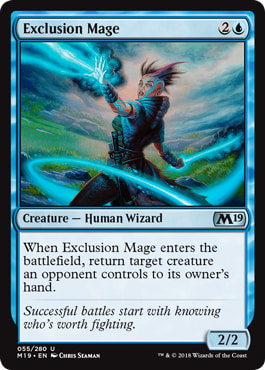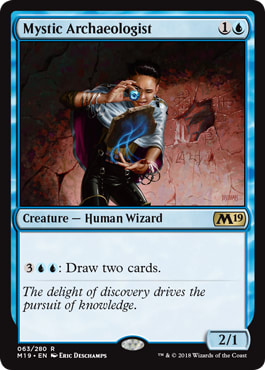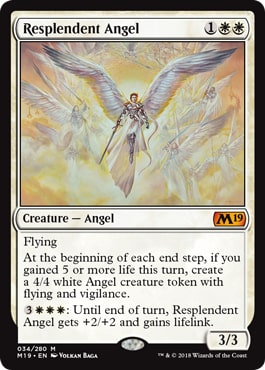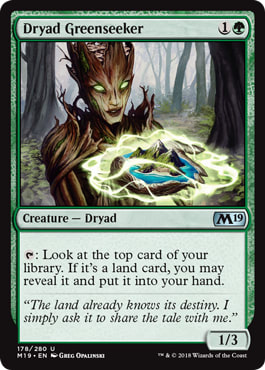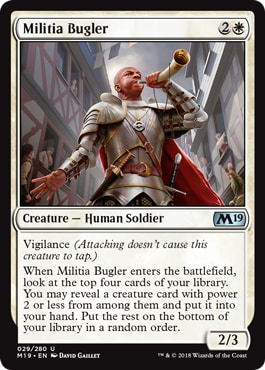Core sets have historically been good for Cube, with cards like Sun Titan, Jace, Vryn's Prodigy, Goblin Rabblemaster, Thragtusk among many others. This set, like other recent sets, has given Cube designers some non-obvious includes for our Cubes. There isn't the usual 1-mana 2/1 with upside in this set, but there are a lot of non-obvious and solid inclusions to discuss.
Cards will be talked about with consideration in the context that Battlebond will be released (these cards will be reviewed for Cube in an another article) If a card isn't included here, it isn't very good and, as you can see, this article is long enough as is!
Of note: Although this review is coming out after Magic 2019 has been released, know that these evaluations are based on actual play in my Cube and not merely outsourced to speculation or Limited play. If I'm saying a card has been working well based on my experience, it's based on actual Cube experience from trying them out in my Cube and finding the cards have been working well/poorly in my Cube. Decks referenced are 3-0 decks from my Cub. Although it has power and fast mana, results likely will mirror your Cube's results.
Planeswalkers
Ajani, Adversary of Tyrants draws inevitable comparisons to Ajani Goldmane's -1 due to buffing other creatures. Absurd competition at four mana in White and inevitable comparisons to long-standing Cube staple Ajani Goldmane have caused it to be overall underrated, especially since it's done so with the context that this planeswalker's +1 is worse than Ajani Goldmane's -1 -- but having a +1 ability perform worse than a -1 shouldn't be a slight against it.
In his review, LSV pointed out that this Ajani follows the line of many other Ajani planeswalkers like Ajani Goldmane by being pretty mediocre when behind and being more of an anthem type of effect for attacking decks. Because of this, it's not very useful in low-creature control decks either.
His -2 is, in theory, a way to help when behind in those decks by being able to get something out the grave and keep the assault going if need be. Many Mulldrifters (creatures with value outside of their bodies) tend to cost 3+ mana like Man-o'-War and Ravenous Chupacabra, so in aggressive decks he's mainly bringing back efficient creatures that operate more on the Baneslayer (creautres whose value is tied to the body of the creature itself) axis, some exceptions aside, like Stoneforge Mystic. This deck found it to work well as a way to push forward momentum on creatures.
Example Deck #1 -- Cube | Usman Jamil
- Creatures (18)
- 1 Adanto Vanguard
- 1 Archangel Avacyn
- 1 Arena Rector
- 1 Baneslayer Angel
- 1 Blade Splicer
- 1 Brightling
- 1 Dryad Militant
- 1 Hallowed Spiritkeeper
- 1 Hero of Bladehold
- 1 Leonin Warleader
- 1 Lyra Dawnbringer
- 1 Mardu Woe-Reaper
- 1 Resplendent Angel
- 1 Skymarcher Aspirant
- 1 Stoneforge Mystic
- 1 Student of Warfare
- 1 Sun Titan
- 1 Thalia, Guardian of Thraben
- Planeswalkers (2)
- 1 Ajani, Adversary of Tyrants
- 1 Gideon Jura
- Sorceries (2)
- 1 Council's Judgment
- 1 Day of Judgment
- Enchantments (1)
- 1 Legion's Landing
- Artifacts (2)
- 1 Heirloom Blade
- 1 Sigiled Sword of Valeron
- Lands (16)
- 13 Plains
- 1 Blinkmoth Nexus
- 1 Karakas
- 1 Strip Mine
The drafter said that he didn't really use the -2 ability too often, but this deck didn't really seem to have a lot of "Mulldrifters" to bring back, aside from Stoneforge Mystic. It was nice as a backup to help shore up some of the weaknesses that previous White Ajani cards have on empty boards -- not doing very much. This does require being in the later stages of the game when early forces are killed, but it's a good way to get something out of an anthem-style card.
Other decks like W/X midrange can bring back some value creatures like Wall of Blossoms/Wall of Omens, but I found that this wasn't used often and was almost always used as an anthem-style card. As good as Ajani Goldmane is, he's essentially a 1-ability planeswalker, but with an ability that is extremely good, with his + being used to mainly keep himself alive.
Although White 4-drops can be tough to compete with, I've found that this Ajani stacks up decently well with them, but may have rough competition with another White 4-drop.
Tezzeret, Artifice Master -- When looking at this, it can be tempting to say that it's just for artifact decks since his 0 ability synergizes well with artifacts. Unlike his original form, he works well with artifacts but tends to not really need that much help, since he creates evasive chump blockers.
Drawing 2 on a planeswalker ability is almost never seen and is very pushed if it can get active, which I've found isn't incredibly hard to pull off in most Blue decks that utilize mana rocks and/or artifact finishers. Curtailing mana rocks may make the speed of hitting metalcraft slower by a turn or two, but I found that it isn't incredibly hard to accomplish. His +1 ability to make thopters does help to hit metalcraft, but since his tokens can find themselves used as chump token fodder, he may not be able to help as much as you may think on that axis, but the abilities do synergize well. Overall, he's very good and he's worked well in Blue control and midrange decks as a value engine and threat generator.
Vivien Reid is similar to a lot of other recent 5-mana planeswalkers with a + mode that has some form of card advantage, can minus to protect itself/kill something, and has some ultimate that you'll hardly ever reach. Usually these kinds of cards that look at the top X cards of your library don't tend to work as well in Cube, but I've found that when she was using her + ability, she never really missed since at worst, she could hit lands. Green midrange decks usually found a creature and creature-based ramp decks utilized her very well since the creature toolbox worked with her plus ability with the fail-safe of either getting a mana dork or a land.
She ends up being a card drawing machine that acts similar to cards like Wickerbough Elder and Freyalise, Llanowar's Fury as a hedge against artifacts and enchantments. Also, the ability to hit fliers being surprisingly relevant (generally, she performed better than Freyalise.) However, even though she nearly never misses, I've found that sometimes just hitting a land may not help advance the game state in your favor. Usually her plus ability ends up finding something useful, even if it takes a few turns to do so.
Green 5-drops generally manifest in large creatures that gum up the ground and planeswalkers like Nissa, Vital Force, Nissa, Worldwaker, Garruk, Primal Hunter and others. This joins the latter as a solid value engine and doesn't really knock any of those out of the park -- a good solid Green planeswalker which isn't the hero that we're looking for, but a nice addition to the roster.
The new Liliana and Sarkhan are a possible sea change in direction of planeswalkers by being tribally oriented. In Cube, there just isn't enough support to make these work (tribal linears never really do) and they don't really do enough on their own, especially Liliana, making them a very easy pass.
Graveyard Things
Graveyard Marshal is a great boon for Black aggressive decks by being able to utilize creatures from the graveyard which aren't recursive threats; while Black aggressive decks generally tend to play them, there are inevitably some cards like Dark Confidant which are great for the aggro plan but don't recur themselves.
Decks like these:
Example Deck #2 -- Cube| Usman Jamil
- Creatures (16)
- 1 Blood Artist
- 1 Bloodsoaked Champion
- 1 Drana, Liberator of Malakir
- 1 Dread Wanderer
- 1 Etched Champion
- 1 Gifted Aetherborn
- 1 Gnarled Scarhide
- 1 Gravecrawler
- 1 Gurmag Angler
- 1 Hangman
- 1 Josu Vess, Lich Knight
- 1 Nightveil Specter
- 1 Oona's Prowler
- 1 Pack Rat
- 1 Rakdos Cackler
- 1 Scrapheap Scrounger
- Planeswalkers (1)
- 1 Karn, Scion of Urza
- Instants (3)
- 1 Cast Down
- 1 Snuff Out
- 1 Wretched Confluence
- Sorceries (2)
- 1 Divest
- 1 Inquisition of Kozilek
- Artifacts (2)
- 1 Cranial Plating
- 1 Fleetwheel Cruiser
- Lands (16)
- 14 Swamp
- 1 Ancient Den
- 1 Vault of Whispers
Example Deck #3 -- Cube| Usman Jamil
- Creatures (10)
- 1 Bloodghast
- 1 Bloodsoaked Champion
- 1 Dark Confidant
- 1 Firedrinker Satyr
- 1 Gnarled Scarhide
- 1 Goblin Bushwhacker
- 1 Hellrider
- 1 Najeela, the Blade-Blossom
- 1 Rakdos Cackler
- 1 Snapcaster Mage
- Planeswalkers (3)
- 1 Chandra, Torch of Defiance
- 1 Koth of the Hammer
- 1 Liliana of the Veil
- Instants (3)
- 1 Searing Spear
- 1 Snuff Out
- 1 Wretched Confluence
- Sorceries (3)
- 1 Demonic Tutor
- 1 Fiery Confluence
- 1 Thoughtseize
- Enchantments (1)
- 1 Sulfuric Vortex
- Artifacts (4)
- 1 Shrine of Burning Rage
- 1 Skullclamp
- 1 Sol Ring
- 1 Tangle Wire
- Lands (16)
- 1 Island
- 4 Mountain
- 4 Swamp
- 1 Arid Mesa
- 1 Blood Crypt
- 1 Lavaclaw Reaches
- 1 Mishra's Factory
- 1 Steam Vents
- 1 Verdant Catacombs
- 1 Watery Grave
It's true that using the graveyard as a resource can have diminishing returns -- a solitary Gurmag Angler can happily chomp on a graveyard, but adding a Murderous Cut/Treasure Cruise to the mix make it so that utilizing the graveyard gets a bit trickier. Generally, there aren't enough cards that utilize the graveyard as a resource for it to be a big factor in Cube design, at least, so far, but it's something to at least consider when it comes to deck design. It's also a great case of an Aggro creature that is useful on turn two or five, by being able to create more warm bodies.
While it costs ![]()
![]() , like with Gifted Aetherborn, this hasn't really been an issue and it's a great card for Black aggro decks.
, like with Gifted Aetherborn, this hasn't really been an issue and it's a great card for Black aggro decks.
Isareth the Awakener is a card that draws comparisons to Alesha, who Smiles at Death as a 3-power 3-mana creature that recurs creatures.
Needing to attack to be able to recur creatures does limit her role to be bad in control decks and not bad in midrange decks, but more for aggressive-leaning decks that don't mind attacking with her. Oddly, while deathtouch tends to be laughably useless on cards like Grave Titan and Noxious Gearhulk, her having deathtouch lets her attack into larger creatures without just offing herself which is something that was a weakness of Alesha.
Like with Graveyard Marshal, there is some non-synergy with recursive creatures where it puts the choice of either using its own recursive mechanic or being brought back with Isareth, only to be exiled, but she helps to bridge the gap and get use out of non-recursive creatures like Dark Confidant. She can't pull Cheatyface shenanigans by being able to get more value out of bringing back things like Angel of Invention for two mana, but being able to bring back curve toppers which may have died is a great upside too. Is it better than Alesha? I'd say that they're close. Black 3-drops have been getting better lately, and this is another great one, provided you have room for it. Great, but not absurd and encourages interesting deck design and gameplay while being a good card, so I'm a fan for Cube.
Stitcher's Supplier is great if enabling graveyard use as a resource, but even that may be not as reliable as you'd think -- reanimation decks don't have enough targets to reliably mill one into the graveyard, and utilizing its body as a resource isn't as easy as you'd think as it'd either require a dedicated sacrifice outlet, dedicated chump block duty, or to be wrathed away. As cliché as it may sound, it's a nice card to look into if you want to go deep with graveyard shenanigans, but a narrow card that only really works in those kinds of decks. Include accordingly to your Cube's design goals.
Bone Dragon has decent base rate and obviously works better in either decks that have ways to get a ton of things in the graveyard. Black 5-drops have been weak outside of Shriekmaw and, arguably, Custodi Lich (and Liliana, Death's Majesty, if counting that) and this is a comparable analogue to cards like Bloodgift Demon -- a giant beater, with some added utility. I've found that it only really gets brought back once and, like Chainer's Edict, it isn't something that you can rely on utilizing from the graveyard in every game, or even match, but it's great if it can happen. It's similar to non-Primeval Titan 6-drops in Green where it's a good card but isn't absurd and may just end up replaced in a year, but it's good enough to compete.
Desecrated Tomb works with cards that utilize the graveyard as a resource, and other Black recursive creatures. However, as it does nothing on its own, the question to ask is how many cards that utilize the graveyard are needed to make this usable in the final 40 of a deck?
Looking at the deck above, are there enough resources to warrant this? Likely not, and this likely will apply to many Cube decks without heavily devoting slots to make sure that this isn't the case. The effect is fine, but may not be worth the effort for potential payoffs. Still, if this is an avenue you want to explore with your Cube, adjust accordingly.
Artifact.dek (but not solely limited to those decks)
Sai, Master Thopterist and Skilled Animator are mediocre 3-drops with some artifact synergy, but don't really provide enough payoff for what they do.
Seth Manfield compared Sai, Master Thopterist to Tireless Tracker in his preview of the card and that's a good point of comparison for Sai. Having a River Kaijin as a body is fine to hold off ground pounders and it's obviously harder to get value out of this than Tireless Tracker, but still has some use.
However, the issue is much like with other narrow cards, where there's a critical mass of cards needed to support it, since cards like Pia Nalaar, Pia and Kiran Nalaar, and Whirler Rogue work just fine without other artifacts, but work better with them.
One of the problems that I've noticed with parasitic cards like Ghirapur Aether Grid is that the critical mass of cards needed to support it is pretty high and, if I had to ballpark it, I'd say at least 10 artifacts are needed. Since Sai only triggers on artifacts being cast, not entering the battlefield, it's even harder to hit this threshold. In the past few months, I've been tooling my Cube in a more artifact-centric direction with cards like Galvanic Blast, among many others, and even in that scope, the critical mass was hard to reach. If you're taking your Cube in such a direction, it's worth a look, but don't be surprised if it doesn't do much -- and if you're running a more general Cube list, it's going to be very hard to support.
Skilled Animator is a Blue riff on things like Awakener Druid and Wall of Resurgence that animate a land. It isn't a giant tempo blowout if the land dies, but cards like these (and Phylactery Lich) which require the use of something else to live tend to not work out well since they become unreliable attackers and blockers, and give card advantage to the opponent. Skilled Animator is no exception and when cards like Wake Thrasher can have a hard time making it into some Cubes because it can be mediocre in control decks, this is worse.
Bring Me Sacrifices
Demon of Catastrophes is a weird card that is analogous to other four mana 6/6 demons -- Abyssal Persecutor and Desecration Demon -- cards that can suffer from "feel bads" when the drawback is awkward, but are overall solid cards.
Like many "Faustian Bargain" demons, this has a similar style, where its drawback can look terrible and can be a fickle savior in some bad scenarios.
The best way to mitigate the drawback is to either use creatures that are either cheap, recursive, generate tokens, or have benefits outside of their bodies, ie Mulldrifters. Because of this, it's harder to include in Black decks than the other demons with drawbacks which find their way into Black midrange decks as well.
For example, look back at the Black decks listed earlier. Bloodghast, Bloodsoaked Champion, and token generators like Najeela, the Blade-Blossom help to mitigate the drawback of having to sacrifice a creature, but is it enough to make it worth playing in the deck? One could make an argument to say that's the case, but I likely wouldn't. If you're on the fence, give it a few reps, but don't be surprised to see it not work out as well as planned.
Fraying Omnipotence is a riff on Pox, which was a Black strategy popular a few years ago. I personally found it really wasn't worth the effort, and while this, in theory, supports those decks, it's just expensive and doesn't even hit lands.
Aggressive-type things
Dismissive Pyromancer and Dark-Dweller Oracle are similar by being Red 2-drops that aren't great beaters but have some late game potential. Dismissive Pyromancer signals at late-game potential more explicitly by being able to rummage and throw himself away if need be to Flame Slash something.
This Red deck was able to use both of them well:
Example Deck #4 -- Cube| Usman Jamil
- Creatures (15)
- 1 Burning-Tree Emissary
- 1 Dark-Dweller Oracle
- 1 Demanding Dragon
- 1 Dismissive Pyromancer
- 1 Earthshaker Khenra
- 1 Firedrinker Satyr
- 1 Glorybringer
- 1 Grim Lavamancer
- 1 Hazoret the Fervent
- 1 Memnite
- 1 Nicol Bolas, the Ravager
- 1 Rakdos Cackler
- 1 Snapcaster Mage
- 1 Thundermaw Hellkite
- 1 Walking Ballista
- Planeswalkers (1)
- 1 Chandra, Torch of Defiance
- Instants (3)
- 1 Abrade
- 1 Fire // Ice
- 1 Fireblast
- Sorceries (1)
- 1 Firebolt
- Enchantments (1)
- 1 Sulfuric Vortex
- Artifacts (2)
- 1 Heirloom Blade
- 1 Skullclamp
Admittedly, this deck was . . .  rather odd and a all-over-the-place, but it's an example of a deck that would use Dismissive Pyromancer as an early beater that can loot away garbage in the later stages of the game. As a 2/2 for 2, it doesn't quite fill the role of a cheap efficient creature, but it at least has 2 power and attacks decently, if not efficiently. Dark-Dweller Oracle works similarly, bridging the gap between aggressive cards and sacrifice engines as it isn't winning any reward on the creature efficiency front either, but it's able to utilize useless bodies into Red "card draw."
Requiring a mana to use it is a big gap from zero mana (although it'd be absurd if it was free). Since its body is pretty small, non-aggro decks aren't in the market for it, but most oddly, Dismissive Pyromancer was more of a non-aggro Red card since it could perform a few functions (but, as seen above, was still fine in an aggressive deck.)
Both of these effects are nice for when the Red aggro deck is in the later stages of the game, looking for reach elements to close out the game and when you don't care about losing bodies. Cards like Scorched Rusalka, where creatures are being utilized as a resource ala Philosophy of Fire, don't explicitly ask for the use of tokens (although tokens and Dark-Dweller Oracle are a great combo) but it's more to act as mini draw spells. Overall, I've been decently impressed with them for Red aggro decks, but I don't think either are staples. They both fit the role of filler Red creatures better than the next two Red creatures: Viashino Pyromancer and Goblin Instigator.
These are similar to Aether Chaser where both are filler 2-drop that would have been heralded about 7 years ago when competition was a lot looser. Nowadays, it's hard to see either of these making waves outside of Pauper Cube (where I'll personally be using the former, but likely not the latter, due to space constraints, as there are approximately a billion good common 2-drops in Red.)
The question to ask oneself is if either of these are better than the generic 3/2 for two in Red, which make about the average-to-low tier of Red aggro 2-drops. Although Viashino Pyromancer gets the beats in as soon as it enters the battlefield, it doesn't have enough damage throughput to keep pace with later stages of the game. Both are options that can be considered but likely competition is better.
Demanding Dragon is a card that I initially dismissed as a store-brand Thundermaw Hellkite, but I've found that its ability to have "haste" while being able to block is nice.
There's a cliché that cards that give the opponent a choice are always bad because the opponent can choose the outcome, but this doesn't in and of itself make a card bad, it just means that the opponent has a choice which may have wildly variant outcomes and in the case of Demanding Dragon, can result in the opponent sacrificing something irrelevant. But, oddly, I found that its ability to play offense and defense was pretty solid for a finisher in racing scenarios. There are also bonus points that Demanding Dragon survives cards like Wildfire and Burning of Xinye, but those decks may not be in the market for this style of aggressive creature.
Many smaller Cubes may not have room for this since Thundermaw Hellkite and Glorybringer are excellent, efficient beaters while cards like Zealous Conscripts, Sarkhan Dragonspeaker, Kiki-Jiki, Mirror Breaker, Siege-Gang Commander, and Goblin Dark-Dwellers are all solid supporting cast members. If your Cube is in the market for another 5-drop to consider, Demanding Dragon may be worth a try.
Control/Ramp
Cleansing Nova is a 5-mana wrath with some utility from being able to Purify the board if need be, but it's awkward in that White midrange and control decks tend to pack cards like Oblivion Ring, mana rocks and other analogues, making this additional mode play awkwardly. Obviously this non-bo scenario won't always come up, nor will it force someone to play Magic badly, but it just doesn't work well compared to other wrath effects, like Rout, Settle the Wreckage, Fumigate, and the many others that I'm forgetting.
It has a niche role for midrange decks being able to have a miser's Shatterstorm type of effect vs artifact-heavy control decks, but it's still a questionable reason to keep a card in your Cube, let alone deck in games 2 (and 3, if applicable.)
Patient Rebuilding feels similar to cards like Jace, Memory Adept, a card cut from Cubes due to its binary nature of being either a fast game-ender or a near-useless card that can't impact a board state and Ashiok, Nightmare Weaver, a fan favorite that mills in smaller amounts. Patient Rebuilding can fall prey to gamestates where it doesn't do enough, but at least can't be attacked in bad board states. It typically at least draws a card, on average, and I found that while it never killed anyone with mill, it was nice for enabling things like Shelldock Isle, so adjust expectations accordingly, as the mill clock won't be as fast as you'd think, but more as a draw engine. Because of this, I'd pass and if needing to make direct mana cost analogues, the new Tezzeret is better.
Runic Armasaur is a weird hate card but since it's inconsistent, its five toughness is the main reason to play this. Not just looking at this in the generic "your opponent gets the choice" vein, but when looking at decks and seeing it in action, there weren't enough targets and wasn't "generally useful" enough for it to be maindeckable.
Goreclaw, Terror of Qal Sisma -- When looking at this card, I looked to see how relevant the 4-power cost reduction would matter from looking past Green-based decks due to its unique ability to reduce big creatures' mana cost by ![]() . I found that, among 3-0 Green decks:
. I found that, among 3-0 Green decks:
Mono-Green ramp decks typically had between 4-6 4+ power cards, with most being between 5 and 6. Green-based midrange decks generally had between 3-6, generally having between 4-6. Targets included cards like Craterhoof Behemoth, which is absurd with Goreclaw, by being able to come out on 6 mana, to cards like Avenger of Zendikar, which was still good, and others like various titans. When looking at these cases, I found that this was a good amount of targets to include for cost reduction. This doesn't even take into account that Goreclaw is, in essence, a 5/4 trampling attacker for ![]()
![]() , which is an unprecedented size for a mana elf style of creature.
, which is an unprecedented size for a mana elf style of creature.
This deck was able to utilize it effectively without a large number of targets:
Example Deck #5 -- Cube | Usman Jamil
- Creatures (13)
- 1 Adanto Vanguard
- 1 Archangel Avacyn
- 1 Baneslayer Angel
- 1 Goreclaw, Terror of Qal Sisma
- 1 Nissa, Vastwood Seer
- 1 Porcelain Legionnaire
- 1 Primeval Titan
- 1 Ramunap Excavator
- 1 Reveillark
- 1 Scavenging Ooze
- 1 Student of Warfare
- 1 Walking Ballista
- 1 Wall of Blossoms
- Planeswalkers (1)
- 1 Elspeth, Knight-Errant
- Instants (1)
- 1 Beast Within
- Sorceries (3)
- 1 Armageddon
- 1 Day of Judgment
- 1 Lingering Souls
- Artifacts (6)
- 1 Batterskull
- 1 Grim Monolith
- 1 Mind Stone
- 1 Mox Pearl
- 1 Mox Ruby
- 1 Smuggler's Copter
- Lands (15)
- 5 Forest
- 5 Plains
- 1 City of Brass
- 1 Gaea's Cradle
- 1 Maze of Ith
- 1 Temple Garden
- 1 Wasteland
This deck had the lower-end of 4+ power cards, but as a "Baneslayer" type of creature, it both represents a threat for being an above-curve beater and a creature that can enable threats, eliciting a "Oh, what's coming now?" reaction if Goreclaw lives. Her ability to make other 4+ power creatures slightly larger and give them trample generally isn't a huge deal, but doesn't hurt as a way to get extra damage in.
Green 4-drops generally aren't very good aside from Oracle of Mul Daya and I've been liking this so far as a creature to help Green ramp and midrange decks.
Meteor Golem is too much mana for what it does and the small 3/3 body attached. Meteor Golem reminds me of Mold Shambler as a clunky way to get rid of planeswalkers while giving colors like Blue and Green some removal for creatures, but it's still coming at a costly price. It has some value as a Tinker/reanimation target, but even in those scenarios, I want more out of my Tinker and ramp targets than having the ability to kill something on a 3/3, but it's nice that for Peasant, it's at least something to Tinker for. Overall, pretty mediocre for Cubes with rares as they have much better robots available.
Transmogrifying Wand has all of the hallmarks of being a weird, meme-able card that doesn't have a home in Cube, as it's sorcery speed, has weird creature types and was previewed on a Loading Ready Run skit, which usually, but doesn't always, mean a card is bad for Cube.
The key, much like with cards like Beast Within, is utilizing it in decks that don't care that the opponent has 2/4s mucking up the ground, by either going around the oxen or over the top of them. The wand has some use for upgrading smaller creatures, which I've found can be nice if there's nothing better to do -- cards like Beast Within offer this functionality too, but being a 1-for-1 card, it's generally worse in terms of card economy for doing that type of upgrade, whereas a card that has multiple charges like Transmogrifying Wand can perform this function better. A deck that utilized it well found itself turning all kinds of things like Griselbrand, Primeval Titan, Baneslayer Angel and assorted other creatures into 2/4s:
Example Deck #6 -- Cube | Usman Jamil
- Creatures (9)
- 1 Consecrated Sphinx
- 1 Courser of Kruphix
- 1 Hangarback Walker
- 1 Kuldotha Forgemaster
- 1 Myr Battlesphere
- 1 Oracle of Mul Daya
- 1 Tireless Tracker
- 1 Walking Ballista
- 1 Wurmcoil Engine
- Planeswalkers (4)
- 1 Dack Fayden
- 1 Garruk Wildspeaker
- 1 Tamiyo, the Moon Sage
- 1 Ugin, the Spirit Dragon
- Instants (2)
- 1 Counterspell
- 1 Mystic Confluence
- Enchantments (2)
- 1 Ghirapur Aether Grid
- 1 Patient Rebuilding
- Artifacts (9)
- 1 Coalition Relic
- 1 Golgari Signet
- 1 Mind Stone
- 1 Mox Ruby
- 1 Rakdos Signet
- 1 Simic Signet
- 1 Smokestack
- 1 Sorcerous Spyglass
- 1 Transmogrifying Wand
Other decks, like Green ramp, have utilized it well, much like Beast Within, especially given the somewhat cheap ![]() cost to activate once it's online. I haven't seen aggro decks utilize it as a way to upgrade cheap creatures, but it seems like a loose strategy.
cost to activate once it's online. I haven't seen aggro decks utilize it as a way to upgrade cheap creatures, but it seems like a loose strategy.
Although it doesn't do very much against hasty creatures, it's a great way to downgrade larger beaters and to help make games where cheating a big creature like an Emrakul into play a big more lopsided.
It isn't a windmill slam include, but it's better than you think.
Nicol Bolas, the Ravager and his trio of dragons represent powerful options in slots which tend to be limited in Cube, since a 3-color card needs to really pull its weight to make up for the fact that not a lot of decks want these cards. The two standouts of this cycle are Chromium, the Mutable and Nicol Bolas, the Ravager. It isn't that cards like Arcades, the Strategist and Palladia-Mors, the Ruiner are bad, and it's easy to say that a card is bad in Cube if it's hard to include in a Cube since it'd be just fine in the final 40 of a Cube deck that can include it. It's just that it's hard to find room for them, even if their competition is mediocre (and even still, it's better to just not include suboptimal cards to bad out tri-color slots, even if we have better options than Guided Passage and Fervent Charge in 2018.)
Designer Ethan Fleischer has talked about Magic 2019 design on twitter and he said that the new Bolas was designed primarily as a midrange threat, a la Siege Rhino with a strong enter-the-battlefield trigger on a good body, with a great backside if it gets to that state; I've found that Curator of Mysteries' 4/4 body for four works well to just bash faces and planeswalkers, and the new Bolas performs that role well.
In Cube, it's harder for someone to cast this on turn four than on turn seven since we can't craft perfect mana bases, but even in those scenarios, he works well as he doesn't need to wait for more lands to come out, he just needs to survive. One could consider it as a 11-mana planeswalker that has no room in Cube decks, but it's not a very accurate way to portray how it truly plays out, much in the same vein that saying Student of Warfare is a ![]()
![]()
![]() 3/3 first striker or that Exalted Angel is really a 7-mana 4/5, as using such overly reductive mental shortcuts don't represent its impact on the board state or the ability to pay mana in batches, like with level up cards. Most Cubeable tri-color cards tend to be for control decks and this is one of the few that's great in midrange shells too.
3/3 first striker or that Exalted Angel is really a 7-mana 4/5, as using such overly reductive mental shortcuts don't represent its impact on the board state or the ability to pay mana in batches, like with level up cards. Most Cubeable tri-color cards tend to be for control decks and this is one of the few that's great in midrange shells too.
Once he flips, he does do what Jace, Chandra, and Liliana do, but better even if it was unintentional and found that he can pull the caster ahead very well if he isn't killed on the spot. Since he flips with so much loyalty, much like Karn, Scion of Urza, I've found that he defends himself well on that front from combat and burn and his ability to kill creatures/planeswalkers and reanimate them, helps to defend from solitary threats and if, heaven forbid, he's on an empty board, drawing 2 cards while going to 9 loyalty is backbreaking, putting immense pressure on the opponent to deal with it quickly or lose. He does have the weakness of being unable to deal with non-creature, non-planeswalker threats, but since his ability to go ahead or stabilize in most board states is great, this isn't a huge strike against him. Flipping him also makes him lose out on the benefits of being a creature, like being able to kill opponents and block, and thus, it isn't always a "strict upgrade" to flip him, but it's generally an upgrade to do so.
Look back to the awkward nearly Mono-Red deck that had him -- the deck would have found putting a Nicol Bolas planeswalkers to be a pipe dream, as it'd be a near mulligan in a deck with such a low curve. But a 4-drop dragon didn't suffer from the same fate and was able to be cast either on curve or a turn after, while being able to flip in some games and just dominate the board state.
There's the argument that it may just die in response to the ability, and while this can happen, interpreting fear-based worst-case scanarios, like Goblin Rabblemaster and Ophiomancer dying immediately without generating a token or Aetherling immediately getting killed can happen, but come from a distorted view that discards reality in lieu of viewing things from probable but not oft-occurring scenarios and relies on outliers rather than the average.
Grixis has a lot of great cards -- Kess, Dissident Mage, Nicol Bolas, God-Pharoah and others like Cruel Ultimatum. I wouldn't consider this to be head-and-shoulders above any of them, but I've been happy with his performance so far. He fills a nice role in not being a card that requires a 7-8 mana investment upfront, while still being a good threat in midrange and control decks.
The obvious analog for competition is Sphinx of the Steel Wind, a fan favorite with a billion keywords that works well with Tinker and Reanimation strategies, both being surefire ways to make a tri-color card work in Cube, by essentially ignoring its tri-color mana cost.
Admittedly, I'm a huge proponent on creatures with flash, especially in control decks, as it allows the caster to hold up countermagic and to utilize the mana if the opponent does nothing. Of course, flash alone doesn't make a finisher good for Cube, ala Pearl Lake Ancient, although it certainly helps to push some cards over the top, like Torrential Gearhulk.
If Sphinx of the Steel Wind comes out either via reanimation or Tinkering into play, it represents a large threat that can change the dynamic of the game if unanswered, since it's huge and has lifelink and vigilance and if deployed for 2-4 mana, makes it can be protected with countermagic.
The problem is that Sphinx of the Steel Wind, when not cheated into play, plays a mostly redundant role with a lot of Esper cube finishers like Elspeth, Sun's Champion, Aetherling, Grave/Sun Titan, Consecrated Sphinx, Wurmcoil Engine and others which perform a similar role -- stabilize the board at sorcery speed and requiring that you either deal with it or it will kill you quickly.
Some of these have forms of protection, Aetherling can blink itself, Wurmcoil Engine replaces itself with smaller tokens if it dies, and Sphinx of the Steel Wind does, to an extent, by being immune from the various Shatter effects that Red and Green and Terror effects in Black, but doesn't do a whole lot against other effects.
Chromium, while requiring the use of a card to protect itself, does so without additional mana resources, which is why cards like Pearl Lake Ancient never really worked out, as protecting itself required the use of too many resources to compete with other finishers in Cube, even though it was much better than initially thought in Standard, but it still fills a great role that most non-Torrential Gearhulk threats don't cover -- a giant threat that protects itself that can be deployed at instant speed.
As PV pointed out, Chromium can be awkward if blocked and the opponent aims a removal spell on him, so its protection isn't bulletproof, but overall, Chromium is a solid finisher that works well with Azorius, Dimir and Esper decks. Inclusion depends on whether you want to explicitly support ways to cheat it into play (Sphinx of the Steel Wind) or for general control decks (Chromium) but either is acceptable.
Miscellaneous
Sigiled Sword of Valeron is unfortunately another equipment in the vein of Captain's Hook.
Equipment has gone under a deliberate downshift in power and unfortunately, this is another casualty of the downgrade with Heirloom Blade and the Bloodforged Battle-Axe being the only real exceptions for Cubes with rares, as the rest just haven't been good. When trying it Sigiled Sword of Valeron, I found that it could snowball if the equipped creature was able to swing and not die before being able to make a knight/die to blockers, but it was such a high mana cost and provided such little value upfront that it just didn't do much. While it may have had a chance with its original equip cost of 2 but at 3 mana, it's just too much.
Nexus of Fate gets points for being an instant speed Time Walk effect, which allows the caster to hold up mana and utilize the effect at EOT if need be, with a self-shuffling effect with its own benefits/costs (tutorability after being played but can't be recurred from the graveyard) but, at the end of the day, seven mana is just too much for this kind of effect.
Exclusion Mage is Man-o'-War with some tribal-relevant riff and a slight boost/drawback for being able to be cast on an empty board at the cost of being unable to bounce your own creatures, but in the grand scheme of things, both of these are very small changes and don't really push things one way or the other . . .  but it's likely a slight improvement on the ol' Jellyish (even if people may need to suck it up and play their 2/2 bouncers on empty boards to end the game.) Because of this, you can likely have both in your Cube but YMMV.
Mystic Archaeologist is a riff on Azure Mage. I've talked in previous articles about the myriad of 2/1s for two in Blue that Blue decks generally don't want. Control decks aren't typically in the market for Goblin Piker/Welkin Tern types of creatures, aside from Snapcaster Mage. Cards like Dimensional Infiltrator and Skyship Plunderer see less Cube adoption than they would if they were in a color like White as a result.
Because of this, these cards have a harder time in most Blue sections that aren't explicitly pushing Blue tempo strategies. Arguably, this can act as a cheap threat that can grind out value from excess mana that's lying around/unused from holding up countermagic, but the failsafe of not being able to reach those board states is just a Cube slot.
Leonin Warleader has some obvious analogues with "army in an attacking can" types of creatures that trigger on attacking, ala Hero of Bladehold, Hanweir Garrison, and Najeela, the Blade-Blossom. Very impressed so far, tends to severely impact board states. As noted in the Ixalan review with Adanto Vanguard, there aren't a lot of ways for White to utilize life as a resource, so lifelink isn't the most relevant thing in aggressive decks, and even though aggro decks don't really care about having lifelinking cat tokens with less overall attacking power than Hero of Bladehold (7 vs 6), I've still found Warleader as a sizable threat which tends to have more homes than Hero of Bladehold, which never really took off in non-aggro decks.
Much like Hero of Bladehold, there's a cliche that it "dies to removal" and that White 4-drops are extremely powerful. That applies here, and inclusion ultimately rides with if you want another Hero of Bladehold style of card in your Cube.
Resplendent Angel is yet another great three in White, but one that has performed better thus far in my cubing experience thus far.
It's better than you'd think, playing the role of a sizable threat, as a 3/3 flier for 3 is almost unheard of outside of cards like Serendib Efreet/Fettergeist with the closest analogue being the absurd Flickerwisp. There's the argument that, since it typically requires pumping mana into it get Serra Angels out, that it requires a lifegain theme but this seems like focusing on the wrong thing ala Additive Distraction, when it's mainly to be used as a way to spam out Serra Angels if it's able to be used. In a way, it acts similarly to the new Nicol Bolas by being a decent threat when on board and taking a few turns to set up something absurd, so long as it lives. There aren't a lot of effects in Cube that gain 5+ life outside of lifelinking giants, Thragtusk and a few other things, so Resplendent Angel has to get there on its own, but that isn't too difficult.
I've found that it's a lightning rod style of creature that can provide a big ROI on pump if it comes down to it as it snowballs pretty quickly once a Serra Angel gets created and midrange White decks can more easily get to where ![]()
![]()
![]()
![]() can be used.
can be used.
That said, it isn't a top-tier White 3-drop and with recent competition -- Benalish Marshal, History of Benalia, Brightling in just the past few sets -- the issue with getting one is that its shelf life may not last very long and another absurd 3-drop in another set or two will relegate it to the Cube sideboard. But it's still a good creature to try out.
Dryad Greenseeker is an innocuous-looking take on cards like Courser of Kruphix and Oracle of Mul Daya with an important distinction: this only reveals the top card of your library to you. Usually this isn't a huge deal, but it can be annoying in midrange and ramp decks to let your opponent know that a big threat is coming next turn and to save a kill spell for it, but being able to get around that is still nice. Like Oracle and Courser, the peek ability works well with shuffle effects to get rid of useless things and to help plan for the next turn or two. Being on a cheaper body is nice and 1/3s block value 2/2s all day. Admittedly, I haven't gotten that many reps with this as a friend got me interested in this card late in the writing process, so while I don't have hard data to support it, I'm excited to try this one out, especially in peasant!
Remorseful Cleric hearkens back to when supporting aggro in cubes was new and supporting aggressive decks meant needing to use small creatures like Black and White Knight, Hearth Kami and other cards which werecommonly used as 3-power 2-mana creatures was the exception, rather than the rule, so the fail-case of having a 2 mana first striking 2/2 was fine, as it helped aggro decks get to the required critical mass of early creatures to support beatdown strategies.
Due to creature power creep, the acceptable fail-case has risen and 2/2 first strikers for 2 are no longer acceptable as a fail-case and rare-including cubes don't bother with cards like Reckless Reveler, White Knight, and Torch Fiend and even non-huge Pauper and Peasant Cubes don't bother with those ![]()
![]() creatures. There aren't many direct analogues for 2/1 fliers for 2 with upside but Selfless Spirit, Warkite Marauder, Bearer of Silence, Rattlechains and Stratus Dancer give us a nice baseline for a Mistral Charger with upside.
creatures. There aren't many direct analogues for 2/1 fliers for 2 with upside but Selfless Spirit, Warkite Marauder, Bearer of Silence, Rattlechains and Stratus Dancer give us a nice baseline for a Mistral Charger with upside.
I noted earlier in the article that Blue isn't in the market for 2/1 fliers for 2, because many Blue midrange and control decks aren't in the market for a Mistral Charger with upside since it's not big enough nor impactful enough for their gameplan and I personally can't think of the last time I've seen Selfless Spirit played in decks aside from aggro and tempo at least in 3-0 deck representation.
Some efficient creatures perform the role of incidental hate while being efficient creatures on their own, like Scavenging Ooze, which is amazing against decks with creatures, but it's obviously better against cards that care about the graveyard and Flickerwisp, which resets opposing planeswalkers while also interacting with a slew of other Cube cards.
Efficient "hate lions" like Mardu Woe-Reaper are great cards for aggro decks since even if they may not hit their intended target in all matchups, they're performing their role as efficient beaters by attacking for 2 for 1 mana. While Mistral Charger and Savannah Lions variants tend to be used in the same deck, the former having evasion does at least help to get through stalled blocking states, hence why Kitesail Freebooter is miles ahead of cards like Mesmeric Fiend.
There aren't many 2/2s for ![]()
![]() that you'll see in Cubes nowadays, aside from the underrated Anafenza, Kin-Tree Spirit and it goes without saying that a 2/1 flier for
that you'll see in Cubes nowadays, aside from the underrated Anafenza, Kin-Tree Spirit and it goes without saying that a 2/1 flier for ![]()
![]() is better than a 2/2 first striker for
is better than a 2/2 first striker for ![]()
![]() . However, that being said, the "random upside" on a 2/1 flier for 2 needs to be higher than the "random upside" on a 2/1 for 1, since the latter works well in aggro decks on a pure efficiency axis. Does its Tormod's Crypt upside have enough value against the field to be worth using in the maindeck of Cube decks? Think back to the 6 decks shown in this article. What does Remorseful Cleric hose?
. However, that being said, the "random upside" on a 2/1 flier for 2 needs to be higher than the "random upside" on a 2/1 for 1, since the latter works well in aggro decks on a pure efficiency axis. Does its Tormod's Crypt upside have enough value against the field to be worth using in the maindeck of Cube decks? Think back to the 6 decks shown in this article. What does Remorseful Cleric hose?
Don't worry, I've got you covered:
Deck 1: Hallowed Spiritkeeper, Ajani, Adversary of Tyrants, Sun Titan
Deck 2: Dread Wanderer, Bloodsoaked Champion, Scrapheap Scrounger, Wretched Confluence, Gurmag Angler, Gravecrawler
Deck 3: Bloodsoaked Champion, Bloodghast, Wretched Confluence
Deck 4: Firebolt, Nicol Bolas, the Ravager, Grim Lavamancer, Earthshaker Khenra, Snapcaster Mage
Deck 5: Lingering Souls, Scavenging Ooze, Reveillark, Ramunap Excavator
Deck 6: nothing
It should go without saying that this appears to be very good against recursive threats and Black decks, with deck 2 having 6 cards adversely impacted by the ability on Remorseful Cleric, but the other decks only have a handful of cards. Even if we go by a pure numbers basis, the impact of Remorseful Cleric's ability is wildly variant, from making Scavenging Ooze losing out on a meal or two to nabbing Lingering Souls, turning it into a bad Midnight Haunting (assuming priority is passed.)
Typically, when I've seen Remorseful Cleric used, generally it ends up in a few ways: incidentally exiling a graveyard in response to a removal spell, which may or may not nab something relevant in the process (frequently the latter), acting as a Seal type of card to act as an on-board trick to deal with cards like Snapcaster Mage or reanimation cards, which only happened in the minority of cases. In most cases, it didn't do much. Therefore, its role as a maindeck threat that hoses a lot of Cube strategies is dubious.
How is it as a sideboard card that can be played in the maindeck? Sometimes, strategy hosers are included in Cube with the context that inevitably, some cards in Cube are going to be late picks and having it so that these low-pick cards should still have a role in Cube, leading to the inclusion of cards like Red Elemental Blast and Linvala, Keeper of Silence. These can also be a stopgap measure to help address metagame issues but these don't address the underlying issues in a Cube's metagame and, even then, it's a luxury that only larger Cubes have. Obviously Remorseful Cleric is better than either of those in the maindeck, but I found that the promise of it having game vs most Cube decks really wasn't there. It's a nice card for aggressive decks but isn't so absurdly powerful that it ends up being a Cube staple for years.
Mirror Image has some use for being a cheap clone that can downgrade creatures if need be, but it's too situational as an aura.
Militia Bugler highlights an issue that often comes up with these kinds of "look at the top X cards of your library and choose one" cards, where they tend to fare not that well in Cube since Cube decks generally aren't as fine-tuned as their Constructed counterparts, which makes it harder to get full value out of something like Lead the Stampede as Cube decks run other things, like removal, planeswalkers, etc.
Militia Bugler is another one of these, where it requires having nearly 1/3 of your deck to be filled with targets with power 2 or less to even be close to hitting, and even in those scenarios, it's acting more like a cantrip for gas rather than selection. Bugler is a paradigm shift where it provides this effect on a much better body -- a 2/3 vigilance for three. Due to aforementioned competition, it's incredibly hard to put in Cubes that include rares and even at uncommon, I found that it wasn't really that great either.
Even looking at this deck from my Peasant Cube:
Example Deck #7 -- Peasant Cube| Usman Jamil
- Creatures (13)
- 1 Aerial Responder
- 1 Dragon Hunter
- 1 Elite Vanguard
- 1 Fairgrounds Warden
- 1 Kongming, "Sleeping Dragon"
- 1 Mardu Woe-Reaper
- 1 Mother of Runes
- 1 Porcelain Legionnaire
- 1 Pianna, Nomad Captain
- 1 Rakdos Cackler
- 1 Serra Angel
- 1 Vampire Lacerator
- 1 Zulaport Cutthroat
- Instants (6)
- 1 Diabolic Edict
- 1 Disenchant
- 1 Harm's Way
- 1 Murderous Cut
- 1 Putrefy
- 1 Snuff Out
- Sorceries (2)
- 1 Demonic Tutor
- 1 Lingering Souls
- Artifacts (3)
- 1 Flayer Husk
- 1 Lightning Greaves
- 1 Oketra's Monument
- Lands (16)
- 5 Swamp
- 7 Plains
- 1 Gemstone Mine
- 1 Sandsteppe Citadel
- 1 Savage Lands
- 1 Vivid Meadow
In this format, this would be one of the better homes for Militia Bugler, but with 11 total hits, is it worth it there (and if so, is it better than something else like Fairgrounds Warden?) It likely isn't and when including rares like Brimaz, King of Oreskos, there's likely not room for the bugler either.
Final Thoughts
This set didn't include any windmill slams, but there are some nice additions for midrange and aggro decks, with a few finishers for control decks. Red 2s got a lot more options to try out, but overall, not a lot changed for Cubes. Still, enjoy this set's offerings for Cube!
My blog, featuring my Pauper, Peasant and powered Cube lists (lists updated as of Dominaria. Powered Cube list gets drafted about every week, with frequent changes and new cards tried in almost as soon as they're previewed/spoiled.)
Cube podcast, The Third Power, that Anthony Avitollo and I host.
Find me on Twitter @UsmanTheRad
Special thanks to @DrRuler for some additional insight and changes on this article. Check out his and @OnekuoSora's Cube podcast here!














